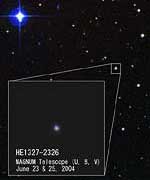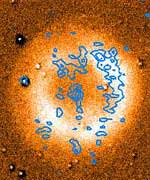Physicists working to re-create the matter that existed at the birth of the universe expected something like a gas and ended up with the “perfect” liquid, four teams of researchers reported at an April 18 meeting of the American Physical Society. One of the teams is led by MIT.
“These truly stunning findings have led us to conclude that we are seeing something completely new–an unexpected form of matter–which is opening new avenues of thought about the fundamental properties of matter and the conditions that existed just after [the Big Bang],” said Raymond Orbach, director of the U.S. Department of Energy’s Office of Science, the primary supporter of the research.
Unlike ordinary liquids, in which individual molecules move about randomly, the new matter seems to move in a pattern that exhibits a high degree of coordination among the particles–something like a school of fish that responds as one entity while moving through a changing environment. That fluid motion is nearly “perfect,” as defined by the equations of hydrodynamics.
Picture a stream of honey, then a stream of water. “Water flows much more easily than honey, and the new liquid we’ve created seems to flow much more easily than water,” said Wit Busza, leader of the MIT team and the Francis Friedman Professor of Physics. Other MIT faculty involved in the work are Professor Bolek Wyslouch and Associate Professor Gunther Roland, both of physics.
Busza notes that the results don’t rule out that a gas-like form of matter existed at some point in the young universe, but the data do suggest “something different, and maybe even more interesting, at the lower energy densities created at RHIC (Relativistic Heavy Ion Collider).”
The research has also led to several other surprises. For example, “there is an elegance we see in the data that is not reflected in our theoretical understanding–yet,” said Roland.
Birth of the universe
About ten millionths of a second after the Big Bang, physicists believe that the universe was composed of a gas of weakly interacting objects, quarks and gluons that would ultimately clump together to form atomic nuclei and matter as we know it.
So, over the last 25 years, scientists have been working to re-create that gas, or quark-gluon plasma, by building ever-larger atom smashers. “The idea is to accelerate nuclei to nearly the speed of light, then have them crash head-on,” Busza said. “Under those conditions the plasma is expected to form.” The current results were achieved at the Relativistic Heavy Ion Collider located at the DOE’s Brookhaven National Laboratory.
RHIC accelerates gold nuclei in a circular tube some 2 kilometers in diameter. In four places the nuclei collide, and around those sites teams of scientists have built detectors to collect the data. The four instruments–STAR, PHENIX, PHOBOS and BRAHMS–vary in their approaches to tracking and analyzing particles’ behavior. The work reported at the APS meeting summarizes the first three years of RHIC results from all four devices. Papers from each team will also be published simultaneously in an upcoming issue of the journal Nuclear Physics A.
MIT is the lead institution for PHOBOS, a collaboration between the United States, Poland and Taiwan. “We are very small,” said Busza, who developed the concept for the device. “STAR and PHENIX each cost about $100 million and have some 400 staff. We cost less than $10 million and have about 50 people,” he said. (BRAHMS is also small.)
Nevertheless, the PHOBOS team got the first physics results from three of the five RHIC experimental runs and tied for first on a fourth. (The fifth run is still being analyzed.)
For one of those runs, the team collected the data, analyzed them and submitted a paper on the work all within five weeks. “That’s unheard of in high-energy physics,” said Busza, who credits Roland with the fast turnaround. “He was the person who managed the extraction of the physics from the data.”
What’s next?
Although the larger RHIC detectors will continue to collect data, PHOBOS has been retired. “From a cost-benefit perspective, we feel we’ve extracted as much knowledge as we can from such a small experiment,” Busza said.
So the team is now looking to the future. The members hope to continue their studies at RHIC’s successor, the Large Hadron Collider (LHC) being built in Europe. That facility will have 30 times the collision energy of RHIC, which will bring the scientists that much closer to the conditions at the birth of the universe. “At LHC we’ll test what we think we learned from RHIC,” Busza said. “We also expect new surprises, perhaps even bigger surprises,” he concluded.
MIT research staff currently involved in PHOBOS are Maarten Ballintijn, Piotr Kulinich, Christof Roland, George Stephans, Robin Verdier, Gerrit vanNieuwenhuizen and Constantin Loizides. Six graduate students are also on the team; the research has already resulted in five theses, with two on the way.
Original Source: MIT News Release


